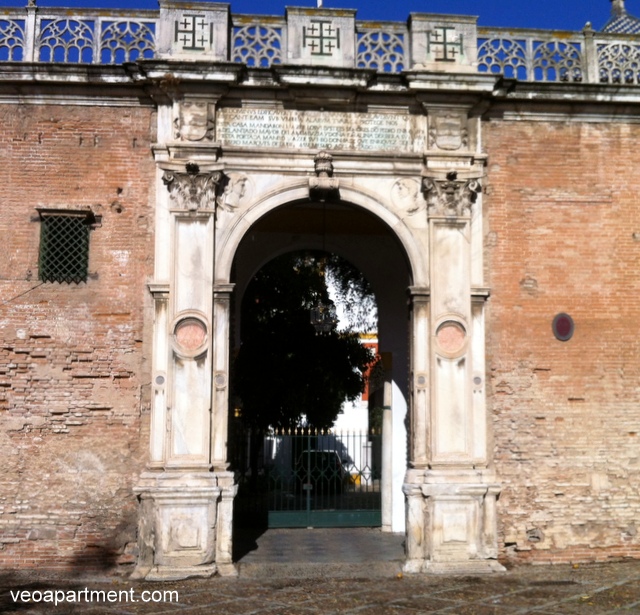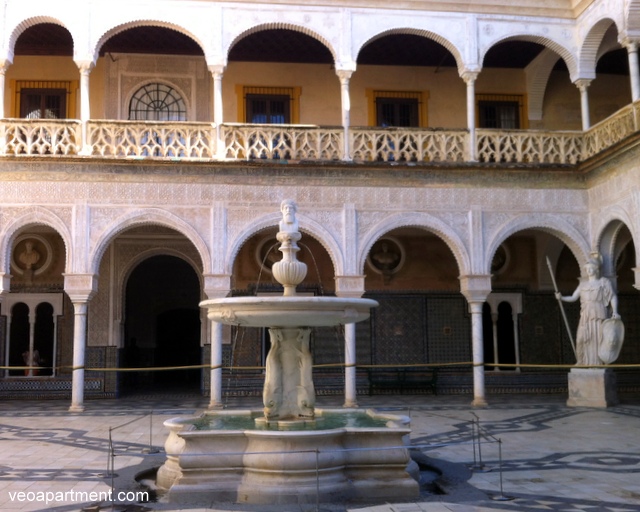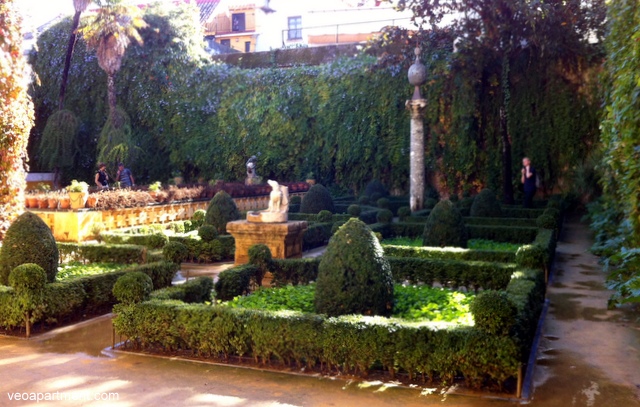 Main entrance on Plaza de Pilatos
Main entrance on Plaza de Pilatos
With the obvious exception of the Royal Palaces of the Alcázar, the Casa de Pilatos (Pilate’s House) is the largest and historically most important of the grand palaces of Seville, and is still the family home of the Dukes of Medinaceli. It can be found in the eastern part of the old city, between the Santa Cruz and Santa Catalina, in the Plaza de Pilatos.
Construction of the palace (originally the Palacio de San Andrés) was begun in 1483, at the transition of the mediaeval to the early modern period, by Pedro Enriquez de Quiñones and his second wife Catalina de Rivera, and was continued by their son Fadrique Enriquez de Rivera, 1st Marquis of Tarifa. In 1519 Fadrique went on a pilgrimage to the holy places of Jerusalem, returning in 1520 by way of Italy, both of which experiences greatly influenced him. The following year he instituted the Holy Way of the Cross as a reproduction of the original in Jerusalem, starting from the palace (which became known as the Casa de Pilatos) and leading to the Cruz del Campo (the Cross in the Field), which can still be seen in the modern suburb of Nervion, and which lends its name to the local beer, Cruzcampo, which used to be brewed nearby.
 Main courtyard with fountain and statuary
Main courtyard with fountain and statuary
Entrance to the Palace is through an Italian Renaissance style gate of the early 16th century, which leads into the apeadero (a reception courtyard for carriages), and beyond that to the Patio Principal, a typical Andalusian courtyard paved with marble, an Italian marble fountain, and colonnades decorated in the Mudejar (Moorish) style. The courtyard is adorned with the busts of twenty four Spanish kings and Roman emperors, with four of the most important pieces of the Palace’s collection of sculptures in the corners.
On the far side of the courtyard is the Palace chapel, known as the Chapel of Flagellation for its central statue of Christ being whipped. Built and decorated in the Mudejar-Gothic style, it’s possibly the oldest room in the palace. To the right is the Praetor’s room, which although a slightly later product of alterations to the courtyard, is notable for the mudejar decoration of its walls, and the beautiful caisson coffered ceiling with the coats of arms of the family line.
 Ceiling of the Praetor’s study
Ceiling of the Praetor’s study
Beneath the tower is the Praetor’s study, which connects the courtyard with the large garden. The walls are covered with ceramic tiles in a number of different patterns and there is a superb ceiling with a ten sided star in the centre.
The grand staircase is probably the most magnificent part of the building, connecting the more public space of the patio with the private family quarters on the upper floor. Sumptuously decorated with colourful tiles, its crowning glory is the mudejar honeycomb ceiling, modelled on the one in the Ambassador’s room in the Alcázar. The upper floor itself recreates the interior of the house palace with mudejar plasterwork and ornate wood ceilings and contains artworks by Francisco Pacheco, Goya and Luca Giordano, among others.
 Grotto in the large garden
Grotto in the large garden
My favourite parts of the palace, though, are the two gardens. The large garden, originally the orchard, was created in the second half of the 16th century by an extension of the palace to enclose it. The layout and decoration are in the Italian renaissance style, complete with a grotto in one corner, and niches for the archaeological exhibits shown there. The small garden (el Jardin Chico) was created from two small gardens in the early 20th century, and has a pool that was once fed by water from the Roman aqueducts, a rare privilege enjoyed by few, and which made owning a garden a sign of social distinction.

The charming Jardin Chico
Casa de Pilatos
Plaza de Pilatos, 1
Tel: +34 954 225 298
Website
Opening Times: 9.00 am to 6.00 pm (7.00 pm Apr-Oct)
Price 8 euros including audioguide and guided tour of upper floor